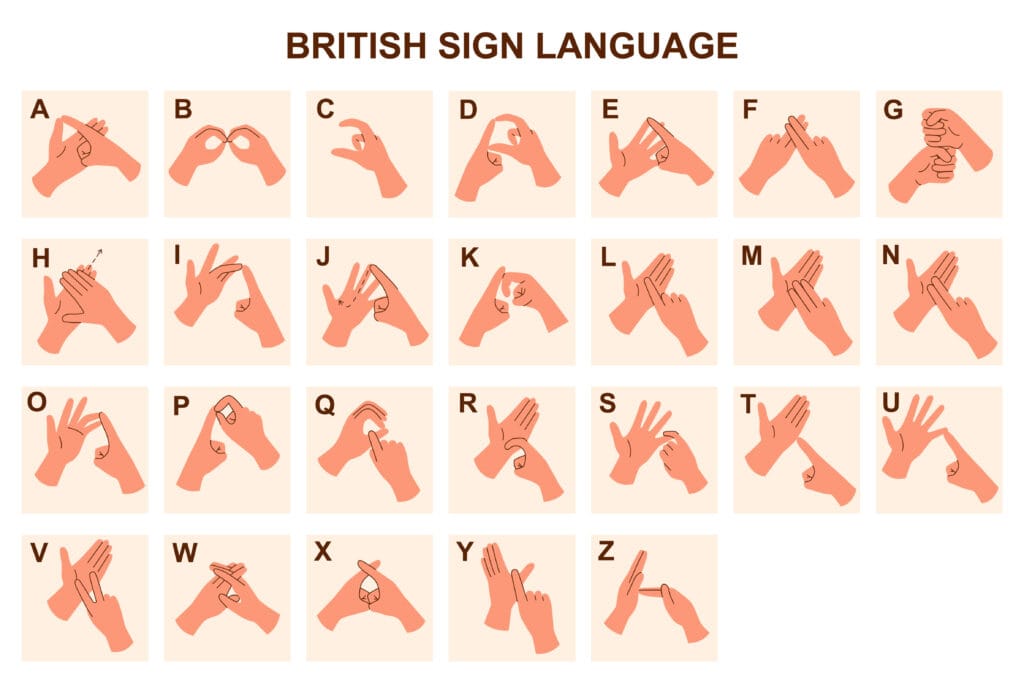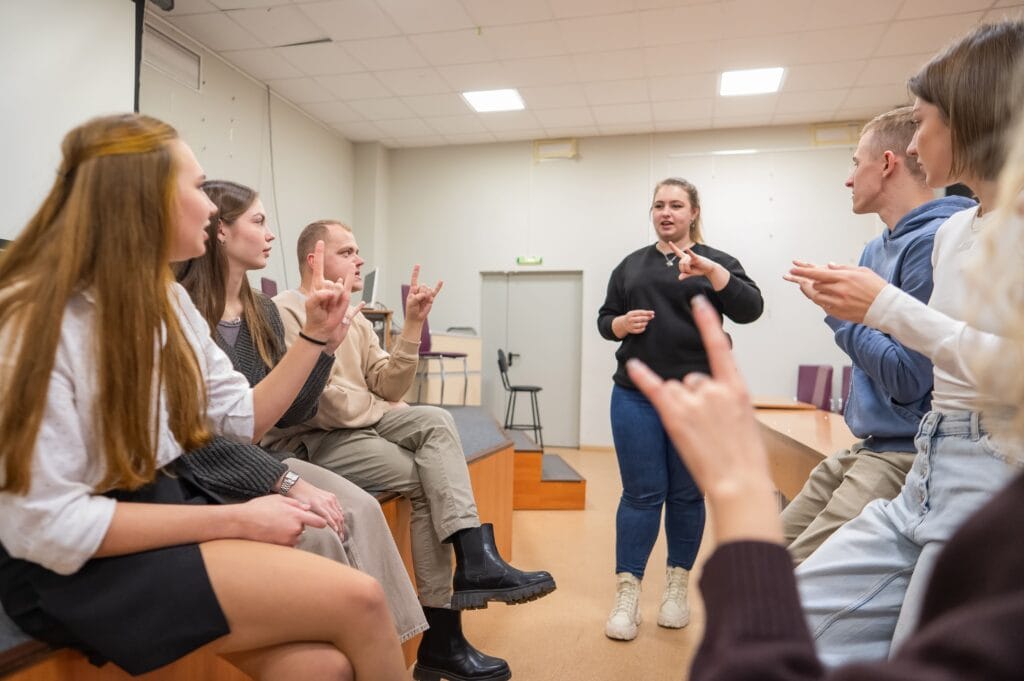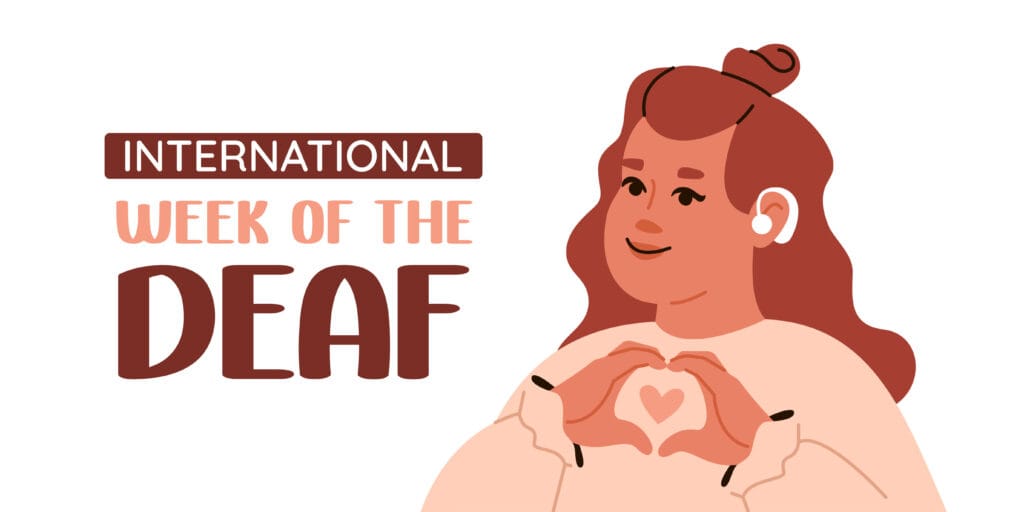Why Communication Goes Beyond Sound
Mark your calendars: from September 22nd to 28th, 2025, the world will see the International Week of Deaf People. Midway through this week, on 23rd September, we also celebrate the International Day of Sign Languages. Both occasions serve as a reminder that communication is not limited to sound alone; it is about connection, inclusion, and being understood.
But these dates are more than just reminders on a calendar. Over 70 million people worldwide identify as deaf, and many more have some hearing loss. For them, communication is not just about how loud or clear something is. It is about having access to language, culture, and opportunities.
This blog goes beyond the dates. It is a way to understanding:
- Deafness Is More Than a Medical Term
- Challenges in Daily Life
- Deaf Culture Is A Community, Not a Condition
- What is Sign Language?
- Why Sign Language Matters in Everyday Life
- Sign Language Activities & Learning Resources
- Technology and Hearing Support
- Myths and Facts About Deafness & Sign Language
- How You Can Support Inclusion
- Hear4U’s Commitment
- Every Voice and Every Sign Matters
- FAQs
At Hear4U, we believe every voice and every sign is important. When we learn about deaf culture and sign language, we help create a society that listens with empathy, not just with our ears.
Deafness Is More Than a Medical Term
Over 5% of people worldwide have some kind of hearing issue. Many people think deafness means total silence, but it actually covers a wide range of experiences. Deafness affects identity, communication, and community in many ways. Here’s how deafness and being hard of hearing are defined:
Deaf vs Hard of Hearing
- Deaf (with a capital “D”): Refers to individuals who identify with the Deaf community and typically communicate using sign language as their primary means of communication. For them, being Deaf is not a medical condition but a cultural and linguistic identity. Sometimes use technology, but do not fully depend on it as a primary way of communicating.
- Hard of hearing: Refers to people who experience mild to severe hearing loss but may still rely on spoken language, hearing aids, or lipreading. Usually identify with the hearing community or be between the Deaf and hearing cultures.
Both groups fall under the broad umbrella of “hearing loss,” but their lived experiences can be very different.
Challenges in Daily Life
- Education: Without accessible classrooms, deaf children may miss out on crucial learning at an early age.
- Healthcare: Without interpreters, medical advice can be misunderstood, sometimes with serious consequences.
- Employment: Communication barriers in interviews or meetings can limit career growth.
- Social Life: Events without captions or interpreters leave many feeling excluded.
A survey by the Royal National Institute for Deaf People (RNID) found that 1 in 5 adults in the UK live with some form of hearing loss. That’s millions of people navigating a world often designed for those who can hear. Nearly 47% of the public report not knowing anyone who is deaf or has hearing loss when asked.
Deafness, then, is not just a medical description. It is a lived reality, one that can either isolate or empower, depending on how society responds.
Deaf Culture Is A Community, Not a Condition
To truly understand deafness, we must view it not only as a health issue but also as a culture in its own right. This includes the social beliefs, behaviours, history, art, and values shared by Deaf people who use sign language.
Shared Language
Language is central to every culture. For Deaf people, sign language is more than just a way to communicate; it is a key part of their identity. It helps with sharing stories, humor, and self-expression. Each country can have its own sign language, like BSL in the UK or ASL in the US. The World Federation of the Deaf reports that 81 countries have some form of sign language legislation, but only about 41% officially recognize their national sign language. Deaf clubs also offer important places for people to meet, socialize, and take part in cultural activities.
Traditions and Arts
Deaf theatre and poetry use movement, rhythm, and visual expression to convey meaning in powerful ways. Storytelling in sign language has its own distinct cadence, rich in visual metaphors and cultural nuance. Storytelling is a cornerstone with a strong tradition of passing stories and jokes through generations. There is a unique art form known as visual vernacular (VV) that combines elements of physical theatre, mime, and poetry to tell stories in a purely visual way. The UK has seen significant advocacy in its history they include the official recognition of British Sign Language (BSL) as a language in 2003.
Belonging and Pride
Deaf clubs, community centres, and schools provide spaces where people are not “different.” Here, communication flows freely, barriers drop away, and Deaf pride thrives. A person’s identity within Deaf Culture is personal. Many deaf or hard-of-hearing individuals do not identify with this, either because they were raised using spoken language or were not introduced to the community until later in life. However, Deaf identity also intersects with other markers like nationality, race, and sexuality, creating a diverse set of experiences within the Deaf community. For example, Black ASL is a distinct variety of American Sign Language used within the Black Deaf community.
Far from being defined by what they “lack,” Deaf people have built a vibrant cultural identity that deserves recognition and respect.
What is Sign Language?
Many assume there is one universal sign language. In reality, there are over 300 different sign languages worldwide, each with its own grammar, syntax, and cultural roots. Sign languages are visual-manual languages that use a combination of hand shapes, movements, and facial expressions to convey messages. Unlike the language we speak, this doesn’t have a manual representation; instead, it has its own unique and complex grammar, syntax and lexical structures.

British Sign Language (BSL)
In the UK, British Sign Language (BSL) is the primary sign language, used by around 150,000 people. It is not a signed version of English; it is its own language with distinct grammar and structure.
For example:
- Word order in BSL is different from English.
- Facial expressions are a key part of grammar.
- Hand shapes and movements combine to create meaning.
Recognition in the UK
In 2022, the UK Government officially recognised BSL as a language. This was a major milestone for Deaf rights, ensuring greater support in public services, workplaces, and education.
Global Variations
- ASL (American Sign Language) is distinct from BSL, despite both being used in countries where English is spoken.
- Other examples include ISL (Irish Sign Language), Auslan (Australian Sign Language), NZSL (New Zealand Sign Language), and many more.
Just as spoken languages are diverse, so are sign languages, and each reflects the history and culture of its community.
Why Sign Language Matters in Everyday Life
Sign language is not just about words. It is about access, equality, and human connection. For Deaf people, it is a primary, native and fully expressive language, not a substitute for spoken language communication. Meanwhile, for hearing people, learning sign language can broaden communication abilities and deepen understanding of the Deaf community.
In Education – For deaf children, access to sign language can mean the difference between thriving and falling behind. Schools that provide BSL support allow children to learn, play, and express themselves fully.
In Healthcare – Imagine sitting in a doctor’s office and not understanding a word being said. Without interpreters, medical appointments can be stressful, even dangerous. Sign language ensures that deaf patients receive safe, accurate care.
In Workplaces – Providing interpreters or captions in meetings allows deaf employees to contribute equally. It is not just about inclusion; it’s about tapping into talent that might otherwise be overlooked.
In Families – For families with deaf members, learning even a handful of signs can transform relationships. A child signing “I love you” or a parent signing “good night” builds bonds beyond sound.
This is beyond the Deaf community, where sign language helps other people with communication difficulties; teaching basic sign language to infants can help them communicate their needs before they are able to speak. For individuals with conditions like autism or apraxia of speech, this can be a more accessible way to communicate, sometimes even aiding in verbal speech development. Ultimately, sign language matters because it turns isolation into participation and silence into connection.

Sign Language Activities & Learning Resources
Learning sign language doesn’t mean becoming fluent overnight. Even small steps can make a difference. The learning resources range from online courses and websites to interactive games and printable materials for all ages.
Simple BSL Signs to Start With
- Hello: A simple wave.
- Thank you: Fingers from the chin moving outward.
- Please: Make a flat hand and draw a small circle on your chest.
- Yes / No: Nodding or shaking fist in a BSL-specific way.
Where to Learn
- British-Sign.co.uk: Offers “fun, easy, & flexible” online courses that introduce beginners to BSL.
- Signature: The leading awarding body for BSL qualifications. Their website features a directory to help you find local, accredited courses. They also offer an online BSL course for beginners.
- Deaf Action: A charity that offers online BSL taster courses taught by qualified deaf tutors. Course income is reinvested into the services for deaf people.
- Apps such as “Sign BSL” or “Lingvano” provide interactive lessons.
- Courses: Many community colleges and local centres offer beginner classes.
- Online Resources: RNID and BSL Zone offer videos and guidance.
Activities in Schools & Workplaces
- Hosting BSL taster sessions.
- Encouraging staff/student challenges (learn 10 signs in 10 days).
- Bringing in Deaf speakers to share experiences.
These activities don’t just build skills; they show respect and a willingness to include others.
Technology and Hearing Support
This is something that has been constantly updated and is becoming more effective and user-friendly support for people. Innovations range from smarter hearing aids and surgically implanted devices to a variety of assistive listening tools and apps. While sign language is vital, technology also plays a key role in bridging communication gaps.
Modern Hearing Aids
Today’s hearing aids are far more advanced than simple amplifiers. Features include:
- Noise reduction.
- Bluetooth connectivity.
- Rechargeable batteries.
- Direct connection to phones and TVs.
Cochlear Implants
For individuals with profound hearing loss, cochlear implants can provide access to sound by directly stimulating the auditory nerve.
Assistive Hearing Devices
- Captioning services for calls.
- Vibrating alarm clocks.
- Video relay services with interpreters.
Digital Tools
Speech-to-text apps, video captioning, and online BSL dictionaries are making communication more accessible than ever.
At Hear4U, we often remind clients: technology complements sign language, not replaces it. Both together create the richest opportunities for connection.
Myths and Facts About Deafness & Sign Language
Myth 1: All deaf people use sign language.
Fact: Communication methods vary. Some lip-read, some use spoken language, others sign, and many mix methods.
Myth 2: Sign language is just hand gestures.
Fact: It’s a complete language with grammar, idioms, and cultural nuance.
Myth 3: Hearing aids “cure” deafness.
Fact: They improve access to sound but don’t restore hearing completely.
Myth 4: Deaf people can’t enjoy music.
Fact: Many do, through vibrations and rhythm. Some even perform as musicians.
How You Can Support Inclusion
Creating an inclusive society doesn’t require big gestures, just conscious steps.
Everyday Actions
- Face the person when speaking.
- Don’t exaggerate lip movements.
- Use clear, simple language.
- Learn basic signs.
In Workplaces
- Offer deaf awareness training.
- Provide interpreters or captioning at events.
- Ensure meetings and videos are accessible.
For Families & Friends
- Encourage open communication.
- Be patient and avoid frustration.
- Celebrate progress in learning signs together.
Health & Hearing Care
Encourage regular hearing checks for yourself and loved ones. Early support makes communication easier for everyone.
Hear4U’s Commitment
At Hear4U, our mission goes beyond fitting hearing aids. We are here to:
- Provide Free Hearing Tests so people can take their first step in hearing care.
- Offer Specialist Audiology Support tailored to each individual.
- Raise Awareness of deaf culture and sign language in our community.
- Support Families through practical advice and long-term care.
We believe that inclusion starts locally. With clinics across the Midlands and a focus on personalised service, we help people reconnect with their families, communities, and themselves.
Every Voice and Every Sign Matters
As we observe the International Week of Deaf People (22–28 Sept 2025) and the International Day of Sign Languages (23 Sept 2025), it is worth remembering: these aren’t just symbolic dates. They’re reminders of what is possible when society values every voice and every sign.
By learning about deaf culture, supporting sign language, and using technology wisely, we can all contribute to a more inclusive world.
At Hear4U, we are here to help you take your next step, whether that is checking your hearing, learning how technology can support you, or simply starting the conversation.
FAQs
1. What is the International Day of Sign Languages?
The International Day of Sign Languages is celebrated on 23rd September every year to recognise the importance of sign languages worldwide. It highlights that sign language is a full and equal language, vital for the rights and inclusion of deaf people.
2. What is the International Week of Deaf People?
The International Week of Deaf People takes place annually in the last week of September. In 2025, it will be from 22nd to 28th September. It celebrates deaf culture, promotes equal rights, and raises awareness of issues faced by the deaf community.
3. Is British Sign Language the same as American Sign Language?
No. British Sign Language (BSL) and American Sign Language (ASL) are completely different languages, with their own grammar and vocabulary. Even though both countries speak English, their sign languages evolved separately.
4. Can hearing aids replace the need for sign language?
No. Hearing aids and cochlear implants can improve access to sound, but they do not replace sign language. Many deaf people rely on sign language as their first language, and technology is best seen as complementary, not a substitute.
5. How can I start learning British Sign Language?
You can begin learning BSL through online courses, apps, or local community classes. Simple signs like “hello,” “thank you,” and “please” are easy starting points. Organisations such as RNID and BSL Zone provide free resources to get you started.
